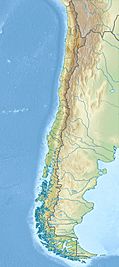Amalia Glacier facts for kids
Quick facts for kids Amalia Glacier |
|
|---|---|
| Skua Glacier | |

Amalia Glacier in 2019
|
|
| Type | Tidewater glacier |
| Coordinates | 50°55′S 73°37′W / 50.917°S 73.617°W |
| Area | 158 km2 (61 sq mi) |
| Length | 21 km (13 mi) |
| Status | Retreating |
Amalia Glacier, also known as Skua Glacier, is a large ice river in Chile. It is a special type of glacier called a tidewater glacier. This means its front end reaches and melts into the ocean. Amalia Glacier is found in the beautiful Bernardo O'Higgins National Park. It sits right on the edge of the Sarmiento Channel, a long, narrow waterway.
This glacier starts high up in the Southern Patagonian Ice Field. This is a huge area of ice and snow in South America. From 1945 to 1986, the front of Amalia Glacier melted back about 7 km (4.3 mi). This was one of the biggest retreats of any glacier in that ice field during that time.
Contents
What is Amalia Glacier?
Amalia Glacier is a massive body of ice. It flows slowly down from the mountains towards the sea. Glaciers are like very slow-moving rivers of ice. They form when snow falls and builds up over many years. The weight of the snow then turns it into ice.
Amalia Glacier is about 21 km (13 mi) long. It covers an area of about 158 km2 (61 sq mi). That's a huge amount of ice!
Where is Amalia Glacier Located?
Amalia Glacier is in the southern part of Chile. It is part of the Bernardo O'Higgins National Park. This park is known for its stunning natural beauty. It has many glaciers, fjords, and mountains. The glacier's front reaches the Sarmiento Channel. This channel is a popular route for ships and boats.
How Does Amalia Glacier Form?
The glacier gets its ice from the Southern Patagonian Ice Field. This is the second-largest ice field outside of the polar regions. It gets a lot of snowfall every year. This snow compacts and turns into ice. Then, gravity slowly pulls the ice down the mountain slopes. This creates the glacier.
The Retreat of Amalia Glacier
Amalia Glacier has been melting back, or "retreating," for many years. Between 1945 and 1986, its front moved back by 7 km (4.3 mi). This is a significant amount of ice loss. When a glacier retreats, it means it is melting faster than new snow can build up.
Why Do Glaciers Retreat?
Glaciers retreat for several reasons. One main reason is a warmer climate. As temperatures rise, glaciers melt more quickly. Less snow may also fall in the winter. This means there is less new ice to replace what melts. The retreat of glaciers like Amalia is a sign of changes in our planet's climate.
Amalia Glacier and Reclus Volcano
Amalia Glacier is also connected to a nearby volcano. It partially surrounds Reclus volcano. The glacier actually helps shape the volcano's northern side. As the glacier moves, it slowly grinds away at the rock. This process is called erosion. It shows how powerful glaciers can be in shaping the land.
See also
 In Spanish: Glaciar Amalia para niños
In Spanish: Glaciar Amalia para niños
- Retreat of glaciers since 1850


